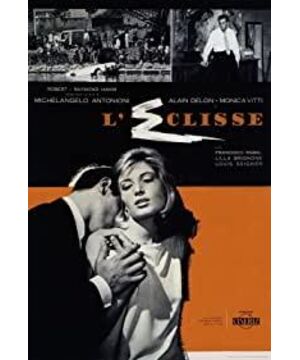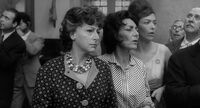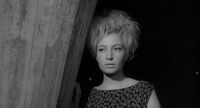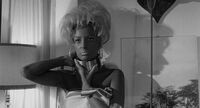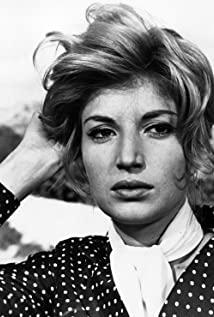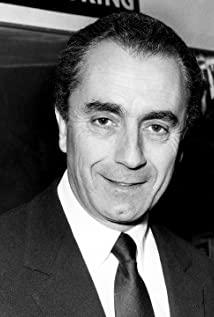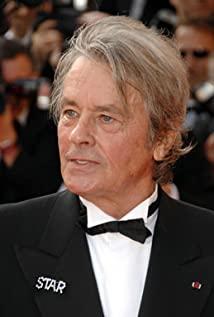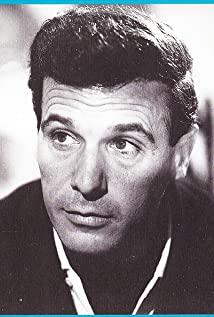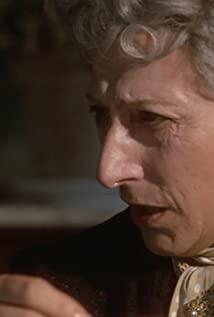If "Night" in Antonioni's "Love Trilogy" focuses on a group of "people", then "Eclipse" focuses on a group of "objects", to be precise A group of objects and the environment.
As a result, we get a lot of boring "empty shots" in this "Eclipse" and those bizarre storylines, such as: Victoria's (Monica Vitti) friend is on the balcony shoot a balloon
A drunk man stole Pierrot's (Alain Delon) limousine and accidentally fell into the water, killing everyone;
Victoria at Pierrot's house is both flirtatious and nonsense...
All of this, plus those "off-axis" shootings are enough to make audiences who are used to watching Hollywood feature films vomit! So, what makes Antonioni's films great? And what makes generations of film lovers and even scholars endlessly discuss and study their films? This requires us to first understand Antonioni's films.
As we all know, An's films are "anti-story". What is an anti-story? This is not simply a confrontation with Hollywood's business routines (unconventional). To use the words of a group of European "new realism" directors: Emphasizing storytelling and pursuing dramatic tension is to destroy the essence and reality of things. At the cost of sex, the real answer to the question is hidden in reality. Therefore, in An's films, all the people and the environment participated in the role-playing. With this perspective, let's look at this "Eclipse"...
The film starts with the breakup of the heroine Victoria and her boyfriend; after that, Victoria spends a day and a night doing nothing; then she meets Pierrot, a handsome stockbroker on the stock exchange, and soon, the two cherish each other. , At this point of the film, it seems that a new love story is about to stand out in this boring picture!
However, as the movie wears off, we finally realize that this love story doesn't seem to have happened at all, or that it didn't exist at all in the interactions between the two (including flirting or gossiping for a walk, etc. things) is no different from those boring scenes before. It seems that the "breakup scene" at the beginning can just be used as the "love ending" of Victoria and Pierrot. It's a pity that at the end of the movie, we don't even know where the hero and heroine have gone. For seven and a half minutes, there are only empty streets, row upon row of buildings and street lamps, and strange faces... Shot" is over.
Obviously, we simply find the way to the movie from this non-existent "love story" will not work at all. In other words: Even a stock trading scene or a drunken stealing a car scene in the play is much more exciting than the hero and heroine's love story. So what exactly is Antonioni trying to convey in this play? If we take a closer look at the inhuman images in this film, you will find a problem, the environment occupies a lot of space and time in the film. Take the beginning of the movie: there's not a single line in the first three minutes, all we see and hear are the dull furnishings, the humming fans, and the two actors walking around the room doing nothing. go. Even though it's a luxury apartment, we feel like the two characters are imprisoned, surrounded by those substances.
It can be said that the directors of all subsequent scenes have emphasized this concept, including the stock exchange; including crowded streets; lined up like a row of cage-like lampposts, and even in the suburbs where the hero and heroine are walking, those who show their teeth and claws. The shade of the tree also covers the figure's head like a skynet.
Yes, this is exactly what Antonioni wants to express in this film: the alienation of man by the environment. Surrounded by this specific environment, all human behaviors, including family, friendship, and love, are distorted and false. It is worth noting that the director did not simply attribute this interpersonal conflict to social class or human nature, but placed him objectively in the environment. In other words, Antonioni did not attribute the contradiction to any one person. The real murderer of the contradiction is the social environment and the substances produced by this environment.
It can be said that no one is better at expressing such complex social issues and relationships in film language than Antonioni. Check out the "Drunk Stealing Car" scene: it seemed like a murder without a killer! If we have to find a murderer, then we can only say that the limousine built under the technological civilization led the drunken man into the bottomless abyss. Watching Antonioni's films, such metaphors abound.
Also worth mentioning is the spatial expression techniques of An's films (open space and cross-axis). Arguably, this iconic shot couldn't be more subtly used to show the alienation of relationships: in Eclipse, the scene in which Victoria talks to a hillside outside Pierrot:
Commercial films usually respect the axis theory of positive and negative play: that is, based on the line between the two sides of the dialogue, one person talks on one side of the frame near the frame and faces the other side, while Antonioni is the opposite, or speaking on one side Turn your back to speak to the other party outside the frame, or the speaker occupies the center of the screen, as if cutting the picture, and both parties are always in an uncomfortable camera space. And in these uncomfortable lens spaces, the "alienation" that An's wanted to express is hidden. ( For details, please refer to "Film Interpretation Tips" below )
Some people say: Antonioni made the same film all his life. In the just past "2016 Born to Be a Movie: Michelangelo Antonioni Retrospective", after the movie "Eclipse" was screened, the audience applauded for a long time, and some people even shouted: "This is the real Antonioni!"
This is probably why everyone loves Antonioni movies!
★ Attachment: Little Knowledge of Movie Interpretation
Let's take a look at this seemingly ordinary and brief "male and female chat scene":
The actor sits on the right half of the screen, with his body facing the left side of the screen, but his head is turned out of the frame behind him and he speaks to the actress who is not in the picture. Furthermore, even if the camera is pulled to the right, the cameraman only "stingy" to let the actress show a pinch of hair and half of her shoulders (there are many such compositions in the film).
This is a compositional technique that will never appear and is absolutely not allowed in traditional "Hollywood commercial films"—that is, "cross-axis" and "open space". So Antonioni does not hesitate to break the audience's traditional viewing habits to shoot. What is the purpose of shooting these "incongruous" pictures? Yes, this shooting method is used to express the "alienation" and "emptiness" of people's hearts. Including every camera angle of male and female characters - upside-down shooting , overhead shot, low angle, high angle, the director seems to use every available means to make his point. Yes, Antonioni really makes the film possible to play to the infinite!
View more about L'Eclisse reviews


